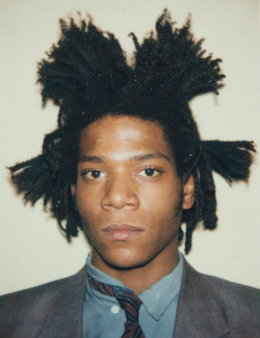
Jean-Michel Basquiat was an American artist who rose to success during the 1980s as part of the Neo-expressionism movement.
Nubians are a Nilo-Saharan ethnic group indigenous to the region which is now northern Sudan and southern Egypt. They originate from the early inhabitants of the central Nile valley, believed to be one of the earliest cradles of civilization. In the southern valley of Egypt, Nubians differ culturally and ethnically from other Egyptians, although they intermarried with members of other ethnic groups, especially Arabs. They speak Nubian languages as a mother tongue, part of the Northern Eastern Sudanic languages, and Arabic as a second language.

Prehistoric Egypt and Predynastic Egypt span the period from the earliest human settlement to the beginning of the Early Dynastic Period around 3100 BC, starting with the first Pharaoh, Narmer for some Egyptologists, Hor-Aha for others, with the name Menes also possibly used for one of these kings.

The Islamization of the Sudan region (Sahel) encompasses a prolonged period of religious conversion, through military conquest and trade relations, spanning the 8th to 16th centuries.

The question of the race of ancient Egyptians was raised historically as a product of the early racial concepts of the 18th and 19th centuries, and was linked to models of racial hierarchy primarily based on craniometry and anthropometry. A variety of views circulated about the racial identity of the Egyptians and the source of their culture. Some scholars argued that ancient Egyptian culture was influenced by other Afroasiatic-speaking populations in North Africa, the Horn of Africa or the Middle East, while others pointed to influences from various Nubian groups or populations in Europe. In more recent times some writers continued to challenge the mainstream view, some focusing on questioning the race of specific notable individuals such as the king represented in the Great Sphinx of Giza, native Egyptian pharaoh Tutankhamun, Egyptian Queen Tiye, and Greek Ptolemaic queen Cleopatra VII.

Nubia is a region along the Nile river encompassing the area between the first cataract of the Nile and the confluence of the Blue and White Niles, or more strictly, Al Dabbah. It was the seat of one of the earliest civilizations of ancient Africa, the Kerma culture, which lasted from around 2500 BC until its conquest by the New Kingdom of Egypt under Pharaoh Thutmose I around 1500 BC, whose heirs ruled most of Nubia for the next 400 years. Nubia was home to several empires, most prominently the Kingdom of Kush, which conquered Egypt in the eighth century BC during the reign of Piye and ruled the country as its 25th Dynasty.
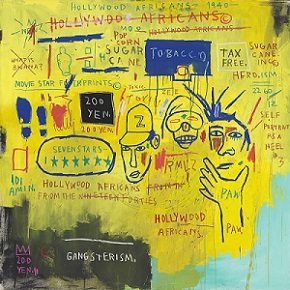
Hollywood Africans is a painting created by American artist Jean-Michel Basquiat in 1983. The artwork is Basquiat's response to the portrayals of African Americans in the entertainment industry.

Untitled (Gem Spa) is a painting created by American artist Jean-Michel Basquiat in 1982. It is an autobiographical work depicting a sparsely rendered figure atop a bicycle "drowned in darkness."

A Panel of Experts is a painting created by American artist Jean-Michel Basquiat in 1982.
Undiscovered Genius of the Mississippi Delta is a painting created by American artist Jean-Michel Basquiat in 1983. Spanning over 15 feet, the artwork is an assessment of select African American history. The painting sold for $23.7 million at Sotheby's contemporary art evening auction in May 2014.

Irony of Negro Policeman is a painting created by American artist Jean-Michel Basquiat in 1981. It depicts a black figure as police officer, however, Basquiat found the idea of the "Negro Policeman" specifically ironic.

During the Trans-Saharan slave trade, slaves were transported across the Sahara desert. Most were moved from Sub-Saharan Africa to North Africa to be sold to Mediterranean and Middle Eastern civilizations; a small percentage went the other direction. Estimates of the total number of black slaves moved from Sub-Saharan Africa to the Arab world range from 6-10 million, and the trans-Saharan trade routes conveyed a significant number of this total, with one estimate tallying around 7.2 million slaves crossing the Sahara from the mid-7th century until the 20th century when it was abolished.
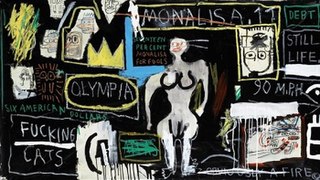
Crown Hotel (Mona Lisa Black Background) is a painting created by American artist Jean-Michel Basquiat in 1982. The artwork cites Leonardo da Vinci's Mona Lisa and Édouard Manet's Olympia, two canonical works of western art. In June 2013, it sold for $7.4 million at Sotheby’s.
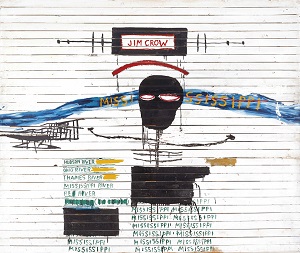
Jim Crow is a painting created by American artist Jean-Michel Basquiat in 1986. In October 2017, the anti-segregation painting sold for $17.7 million at Christie's Post-War & Contemporary art auction in Paris, becoming the most expensive artwork by Basquiat sold in France.

Flesh and Spirit is a painting created by American artist Jean-Michel Basquiat c. 1982–83. The multi-panel painting, which is one of the largest ever made by Basquiat, sold for $30.7 million at Sotheby's in May 2018.

Untitled (Pollo Frito) is a painting created by American artist Jean-Michel Basquiat in 1982. The artwork was sold at Sotheby's for $25.7 million in November 2018.

Sabado por la Noche is a painting created by American artist Jean-Michel Basquiat in 1984. It sold for $10.7 million at Christie's in 2019.

Untitled is a painting created by American artist Jean-Michel Basquiat in 1981. An X-ray-like vision of the head's exposed upper and lower jaw accounts for its misinterpretation as a skull. The painting was acquired by Eli and Edythe Broad in 1982, and is now housed at The Broad museum in Los Angeles.
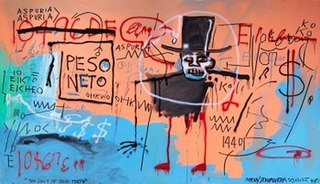
The Guilt of Gold Teeth is a painting created by American artist Jean-Michel Basquiat in 1982. The painting, which depicts Baron Samedi, sold for $40 million at Christie's in November 2021.

Leonardo da Vinci's Greatest Hits is a painting created by American artist Jean-Michel Basquiat in 1982.


















